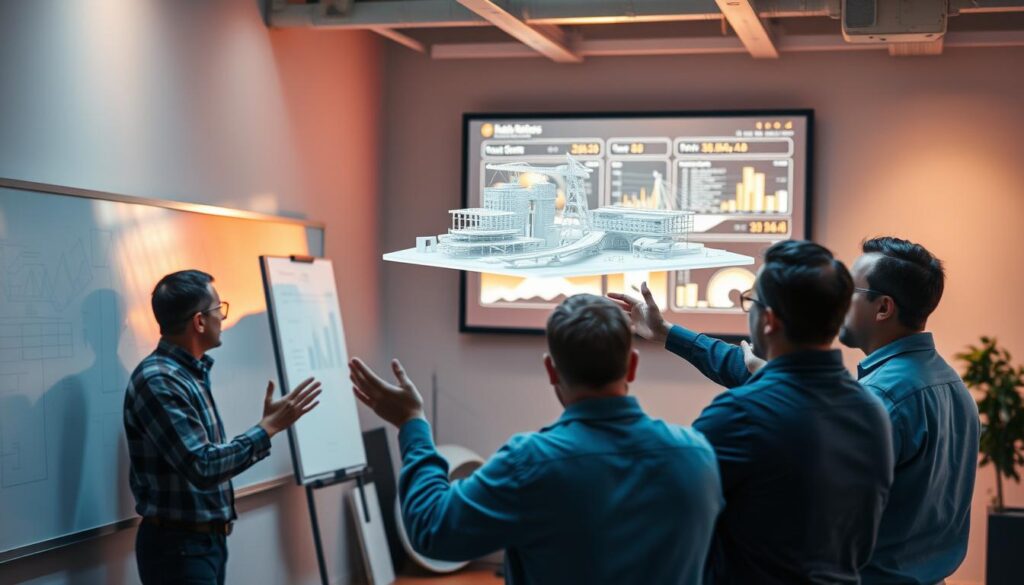The increasing complexity of civil engineering projects necessitates the adoption of innovative management techniques to ensure successful project outcomes. Global collaboration is becoming increasingly important in the sector, with projects often involving international teams and stakeholders.
The use of advanced technologies, such as Building Information Modeling (BIM) and digital twins, is enhancing collaboration and improving project efficiency. These technologies facilitate better communication and data sharing among stakeholders, leading to more effective project management.
Key Takeaways
- Innovative civil engineering projects require advanced management techniques.
- Global collaboration is crucial for successful project outcomes.
- Technologies like BIM and digital twins improve project efficiency.
- Effective communication and data sharing are facilitated by advanced tools.
- Better project management leads to more successful outcomes.
Introduction to Advanced Project Management in Civil Engineering
Civil engineering projects are becoming increasingly complex, necessitating the use of advanced project management methodologies. The unique characteristic of these projects is their ability to solve complex problems, enhance efficiency, and reduce environmental impact through the use of civil engineering software and other innovative tools.
Importance of Project Management in Civil Engineering
Effective project management is crucial in civil engineering to ensure that projects are completed on time, within budget, and to the required quality standards. As stated by a
“A well-managed project is the key to success in the civil engineering sector.”
The importance of project management lies in its ability to coordinate various stakeholders, manage resources efficiently, and mitigate risks.
For more insights on managing civil engineering projects, visit this resource for comprehensive guidance.
Overview of Global Collaboration
Global collaboration in civil engineering projects presents both opportunities and challenges. It allows for the sharing of knowledge, resources, and expertise across borders, enhancing the quality and scope of projects. However, it also requires managing diverse teams and navigating different regulatory environments. Effective global collaboration strategies are essential to overcome these challenges and ensure project success.
Key Challenges in Civil Engineering Projects
Civil engineering projects face numerous challenges, including complex design requirements, environmental concerns, and stringent regulatory compliance. Identifying and mitigating these challenges early in the project lifecycle is crucial for successful project delivery. Some of the key challenges include:
- Managing complex project scopes and stakeholder expectations
- Ensuring compliance with diverse regulatory requirements
- Mitigating environmental impacts and ensuring sustainability
Addressing these challenges requires advanced project management techniques and a deep understanding of the civil engineering sector.
Essential Techniques in Project Management

The application of advanced project management techniques is transforming the construction industry by enhancing collaboration and efficiency. In civil engineering projects, where complexity and scale can pose significant challenges, adopting the right management strategies is crucial for success.
Agile Methodologies for Civil Projects
Agile methodologies, originally developed for software development, are increasingly being adopted in civil engineering projects. Their flexibility and iterative approach allow for better adaptation to changes and unforeseen issues, improving project outcomes. Civil engineering project management benefits significantly from Agile’s emphasis on collaboration and continuous improvement.
Waterfall Method vs. Agile
The Waterfall method, a traditional approach to project management, follows a linear and sequential structure. While it is effective for projects with well-defined requirements and minimal expected changes, it can be less adaptable to the dynamic nature of many civil engineering projects. In contrast, Agile methodologies offer a more flexible framework, allowing for adjustments as the project progresses. Understanding the strengths and limitations of both approaches is essential for choosing the most suitable method for a specific project.
Lean Management Practices
Lean management practices aim to minimize waste and maximize value in project delivery. By focusing on efficiency and eliminating non-value-added activities, Lean can significantly improve project outcomes. Techniques such as value stream mapping and continuous improvement are integral to Lean management, helping civil engineering projects reduce costs and enhance quality.
By embracing these essential techniques in project management, civil engineering professionals can better navigate the complexities of their projects, ensuring successful outcomes and improved client satisfaction.
Tools for Effective Project Management
Advanced project management tools are revolutionizing the civil engineering sector by improving collaboration and project outcomes. These tools are designed to address the unique challenges faced by civil engineering projects, such as complex design requirements, tight deadlines, and the need for precise collaboration among various stakeholders.
Software Solutions for Collaboration
Software solutions play a vital role in enhancing collaboration among project teams. Tools like Building Information Modeling (BIM) enable the creation of detailed digital models, facilitating better communication and coordination among architects, engineers, contractors, and owners. Other collaboration software, such as Procore and PlanGrid, offer real-time data sharing and project tracking capabilities, ensuring that all stakeholders are informed and aligned throughout the project lifecycle.
Project Scheduling Tools
Effective project scheduling is critical to the success of civil engineering projects. Tools like Microsoft Project and Primavera P6 help project managers plan, track, and control project timelines, resources, and budgets. These tools enable the identification of potential delays and bottlenecks, allowing for proactive measures to mitigate risks and keep projects on track.
Communication Platforms
Communication is the backbone of successful project management. Platforms like Slack and Microsoft Teams facilitate real-time communication and collaboration among team members, regardless of their geographical location. These platforms also integrate with various other project management tools, creating a seamless workflow that enhances productivity and reduces misunderstandings.
By leveraging these tools, civil engineering projects can achieve greater efficiency, reduce costs, and improve overall quality. The key is to select the right combination of tools that fit the specific needs of each project, ensuring that all stakeholders are connected and working towards a common goal.
The Role of Technology in Collaboration

Technology plays a crucial role in enhancing collaboration among civil engineers. The integration of digital technologies and advanced methodologies is transforming the way civil engineers design, construct, and manage projects, leading to more efficient, sustainable, and resilient outcomes.
Building Information Modeling (BIM)
Building Information Modeling (BIM) is a digital representation of the physical and functional characteristics of a project. BIM technology allows for the creation of detailed 3D models that can be used throughout the project lifecycle, from design to maintenance. This enables better collaboration among stakeholders by providing a shared knowledge resource.
For instance, BIM can help identify potential clashes between different building systems during the design phase, reducing the likelihood of costly rework during construction. According to a study on the impact of BIM on project outcomes, the use of BIM can lead to significant reductions in project timelines and costs.
Virtual and Augmented Reality
Virtual Reality (VR) and Augmented Reality (AR) are revolutionizing the way civil engineers visualize and interact with project designs. VR creates immersive environments that allow stakeholders to explore projects in detail, while AR overlays digital information onto the real world, enhancing the understanding of complex systems.
These technologies improve collaboration by enabling more effective communication of design intent and facilitating the identification of potential issues early in the project lifecycle. For example, VR can be used to conduct virtual walkthroughs of a project, allowing stakeholders to provide feedback before construction begins.
Drones and Aerial Data Collection
Drones equipped with high-resolution cameras and sensors are being increasingly used in civil engineering projects for aerial data collection. This technology provides accurate and up-to-date information on project sites, enabling better monitoring of progress and identification of potential issues.
Drones can capture detailed imagery and topographic data, which can be used to create accurate 3D models of the project site. This information can be integrated with BIM models to provide a comprehensive understanding of the project.
| Technology | Application | Benefits |
|---|---|---|
| BIM | Digital representation of project characteristics | Enhanced collaboration, reduced errors |
| VR/AR | Immersive project visualization | Improved communication, early issue detection |
| Drones | Aerial data collection | Accurate site monitoring, progress tracking |
The use of these technologies is not only improving project outcomes but also paving the way for the adoption of innovative project management methods in civil engineering. As the industry continues to evolve, the integration of cutting-edge project management techniques will be crucial for delivering successful projects.
Establishing a Global Project Team
In today’s globalized world, civil engineering projects require teams that can collaborate across borders. Effective project management in this context demands a deep understanding of the diverse skills and competencies required, as well as the ability to navigate cultural differences.
Skills and Competencies Required
Managing a global project team requires a unique set of skills. Team members must possess not only technical expertise but also strong communication and collaboration skills. Project managers must be adept at leading diverse teams, often across multiple time zones and languages.
The key competencies required include:
- Technical skills relevant to the project
- Effective communication and collaboration
- Cultural competence and adaptability
- Problem-solving and conflict resolution skills
Cultural Competence in Teams
Cultural competence is crucial in global project teams. Understanding and respecting different cultural norms and practices can significantly enhance team cohesion and productivity. Cultural intelligence enables team members to work effectively across cultural boundaries.
Recruiting International Experts
Recruiting the right talent from around the world is vital for the success of global civil engineering projects. This involves identifying the necessary skills, using appropriate recruitment channels, and ensuring that the selection process is fair and unbiased.
| Recruitment Channel | Advantages | Disadvantages |
|---|---|---|
| Professional Networks | Access to pre-vetted professionals | Limited to known contacts |
| Online Job Boards | Wide reach and visibility | High volume of unqualified applicants |
| Recruitment Agencies | Expertise in candidate selection | Additional costs |
By understanding the skills and competencies required, fostering cultural competence, and recruiting international experts effectively, civil engineering projects can achieve greater success in a globalized world.
Communication Strategies for Global Teams

As civil engineering projects become increasingly global, the need for effective communication strategies grows. Effective communication is vital to the success of these projects, involving the exchange of information among team members to achieve desired outcomes.
Best Practices for Effective Communication
Implementing best practices for communication is crucial in global teams. This includes:
- Establishing clear communication channels
- Defining protocols for regular updates
- Encouraging open dialogue among team members
Clear communication channels help prevent misunderstandings and ensure that all team members are on the same page. Regular updates keep everyone informed about project progress and any changes.
Addressing Language Barriers
Language barriers can significantly hinder communication in global teams. Strategies to address this include:
- Using simple, clear language in communications
- Avoiding jargon or technical terms that may not be universally understood
- Providing translation services when necessary
Regular Updates and Reporting Mechanisms
Regular updates and reporting are essential for keeping stakeholders informed. This can be achieved through:
| Reporting Mechanism | Frequency | Purpose |
|---|---|---|
| Project Status Reports | Weekly | Update on project progress |
| Team Meetings | Bi-weekly | Discuss challenges and align team efforts |
| Stakeholder Updates | Monthly | Inform stakeholders of major developments |
By implementing these communication strategies, global civil engineering projects can enhance collaboration and achieve their objectives more effectively.
Risk Management in Global Projects
Advanced project management techniques are essential for identifying and mitigating risks in global civil engineering projects. Risk management plays a crucial role in ensuring that projects are completed within the defined scope, budget, and time frame.
Identifying Potential Risks
Identifying potential risks involves a thorough analysis of the project’s scope, schedule, and budget to determine potential threats. This process includes assessing internal and external factors that could impact the project, such as environmental conditions, regulatory changes, and stakeholder expectations.
Key risk factors in global projects often include geopolitical instability, currency fluctuations, and differences in legal and regulatory frameworks. Utilizing tools like Building Information Modeling (BIM) can enhance risk identification by providing detailed project simulations.
Mitigation Strategies
Once potential risks are identified, effective mitigation strategies must be developed. These strategies can include risk avoidance, risk transfer, risk mitigation, and risk acceptance. For instance, risk avoidance might involve altering the project plan to circumvent a potential risk, while risk transfer could involve outsourcing certain aspects of the project to third-party vendors.
A robust mitigation strategy also involves continuous monitoring and review of potential risks throughout the project lifecycle. This proactive approach enables project managers to respond swiftly to emerging risks and minimize their impact.
Crisis Management Techniques
Despite best efforts, crises can still occur. Effective crisis management techniques are vital for minimizing the impact of such events. These techniques include having a predefined crisis management plan, establishing clear communication channels, and conducting regular training and drills.
A well-structured crisis management plan should outline the procedures for responding to various crisis scenarios, ensuring that all stakeholders are informed and that the response is coordinated and effective. By being prepared, project managers can significantly reduce the negative impacts of crises on their projects.
Sustainable Practices in Project Management

Sustainability is no longer a buzzword but a critical component in the management of civil engineering projects worldwide. As the industry continues to grapple with the challenges of climate change, the incorporation of sustainable practices has become a necessity rather than an option.
Incorporating Sustainability Goals
Incorporating sustainability goals into project management involves setting clear objectives that minimize environmental impact while enhancing project efficiency. This can be achieved through the adoption of sustainable materials and practices that reduce waste and energy consumption. For instance, projects can benefit from using recycled materials, optimizing energy use through efficient designs, and implementing waste reduction strategies.
To learn more about the impact of sustainable practices in the civil engineering industry, visit this resource for detailed insights.
Green Building Certifications
Green building certifications, such as LEED (Leadership in Energy and Environmental Design), play a crucial role in promoting sustainable construction practices. These certifications provide a framework for evaluating the environmental performance of buildings and encourage the adoption of sustainable design, construction, and operation practices.
- LEED certification promotes sustainable building practices and reduces environmental impact.
- Other certifications, like Green Globes, offer alternative paths to achieving sustainability goals.
Environmental Impact Assessments
Conducting thorough environmental impact assessments is essential for identifying potential environmental risks associated with civil engineering projects. These assessments enable project managers to develop strategies that mitigate adverse effects on the environment, ensuring compliance with regulatory requirements and enhancing project sustainability.
By integrating sustainability into every phase of project management, civil engineers can contribute to a more environmentally friendly and sustainable future. This involves not only adopting green technologies but also fostering a culture of sustainability within the industry.
Legal and Regulatory Considerations
Understanding and adhering to legal and regulatory frameworks is essential for the effective management of international civil engineering projects. These frameworks vary significantly across different jurisdictions and play a critical role in determining project success.
Understanding Local Regulations
Local regulations are a crucial aspect of civil engineering projects, as they dictate the legal requirements and standards that must be met. Compliance with these regulations is not only mandatory but also vital for avoiding legal repercussions and ensuring project continuity. For instance, understanding local building codes, zoning laws, and environmental regulations is fundamental.
Key aspects of local regulations include:
- Building codes and standards
- Zoning and land-use regulations
- Environmental protection laws
- Employment and labor laws
Navigating International Laws
Navigating international laws is another significant challenge in global civil engineering projects. International laws govern cross-border transactions, dispute resolutions, and other aspects critical to project execution. Familiarity with these laws can help mitigate risks associated with international collaborations.
For more information on advanced project management in construction and civil engineering, you can visit this resource.
The complexities of international law require careful consideration of treaties, trade laws, and jurisdictional issues.
Contracts in Global Projects
Contracts form the backbone of any civil engineering project, outlining the terms, conditions, and obligations of all parties involved. In global projects, contracts must be carefully drafted to account for the legal nuances of different jurisdictions, ensuring clarity and enforceability.
Best practices for contracts in global projects include:
- Clearly defining the scope of work and deliverables
- Establishing a dispute resolution mechanism
- Specifying the governing law and jurisdiction
- Including provisions for changes in law or regulations
By understanding local regulations, navigating international laws, and drafting comprehensive contracts, civil engineering professionals can better manage the legal and regulatory complexities of global projects, ultimately leading to more successful project outcomes.
Cost Management Techniques

Global collaboration in civil engineering projects necessitates robust cost management techniques to ensure financial viability. Effective cost management is essential to ensure that civil engineering projects are completed within budget.
Budgeting for Global Collaboration
Developing a comprehensive budget is the foundation of effective cost management. This involves identifying all potential costs, including labor, materials, equipment, and contingencies. For global projects, it’s crucial to consider currency fluctuations and regional cost variations.
Key budgeting strategies include:
- Detailed cost estimation
- Resource allocation planning
- Contingency planning for unforeseen expenses
Cost Control Strategies
Once a budget is established, cost control strategies are implemented to ensure adherence to the budget. This includes tracking expenses, identifying variances, and taking corrective actions.
Effective cost control involves:
- Regular financial reporting
- Variance analysis
- Corrective action plans for cost overruns
Financial Risk Management
Financial risk management is critical in global civil engineering projects. It involves identifying potential financial risks, such as currency fluctuations, inflation, and payment delays, and developing mitigation strategies.
| Risk | Mitigation Strategy |
|---|---|
| Currency Fluctuations | Currency hedging |
| Inflation | Escalation clauses in contracts |
| Payment Delays | Negotiating favorable payment terms |
By implementing these cost management techniques, civil engineering projects can better navigate the complexities of global collaboration and achieve financial success.
Quality Assurance and Control
Quality assurance and control are the backbone of successful civil engineering projects. Ensuring that projects meet the desired quality standards is crucial for the safety, durability, and functionality of the infrastructure.
Setting Quality Standards
Setting quality standards involves establishing clear benchmarks for materials, workmanship, and construction processes. This includes adopting industry standards and best practices, such as those outlined by the American Society of Civil Engineers (ASCE). For instance, quality control measures in construction projects can significantly impact the overall quality of the final product.
To set effective quality standards, project managers should:
- Conduct thorough research on industry standards and best practices.
- Engage with stakeholders to understand their expectations and requirements.
- Develop comprehensive quality plans that outline specific standards and procedures.
Continuous Improvement Approaches
Continuous improvement is vital for maintaining high-quality standards throughout the project lifecycle. This involves regularly reviewing and refining processes to eliminate inefficiencies and enhance quality.
Some effective continuous improvement approaches include:
- Implementing a culture of continuous learning and feedback.
- Utilizing tools and techniques such as Lean management and Six Sigma.
- Encouraging collaboration and knowledge sharing among team members.
By adopting these approaches, project teams can identify areas for improvement and implement changes that enhance overall project quality.
Quality Audits and Inspections
Quality audits and inspections are critical components of quality control. They involve systematic examinations of project processes and products to ensure compliance with established quality standards.
Regular quality audits and inspections help to:
- Identify and address quality issues early on.
- Ensure compliance with regulatory requirements and industry standards.
- Improve overall project quality and reduce the risk of defects or failures.
By integrating quality assurance and control practices into their project management strategies, civil engineers can ensure the delivery of high-quality projects that meet the needs of stakeholders and contribute to the advancement of the field.
Stakeholder Engagement Strategies

The success of civil engineering projects is significantly influenced by stakeholder engagement strategies, which encompass identifying key stakeholders, building relationships, and implementing effective communication plans. Stakeholder engagement is vital to ensuring that projects meet the needs and expectations of various stakeholders, including project sponsors, clients, end-users, regulatory bodies, and the community.
Identifying Key Stakeholders
Identifying key stakeholders is the first step in developing a stakeholder engagement strategy. This involves analyzing the project’s impact on various groups and individuals, understanding their needs, expectations, and levels of influence. Key stakeholders can include project sponsors, clients, end-users, regulatory bodies, and the community. Effective stakeholder identification requires a thorough understanding of the project’s objectives, scope, and potential impacts.
- Project sponsors and clients who have a financial stake in the project.
- End-users who will be directly affected by the project’s outcomes.
- Regulatory bodies responsible for ensuring compliance with laws and regulations.
- Local communities who may be impacted by the project’s construction and operation.
Building Strong Relationships
Building strong relationships with stakeholders is critical to project success. This involves establishing trust, communicating effectively, and managing expectations. Regular updates and transparent communication are essential in fostering positive relationships with stakeholders. Project managers should be proactive in addressing stakeholder concerns and be responsive to their needs.
- Establish clear communication channels to keep stakeholders informed.
- Foster trust by being transparent and consistent in communication.
- Be responsive to stakeholder concerns and feedback.
Stakeholder Communication Plans
A stakeholder communication plan outlines how to communicate with stakeholders throughout the project lifecycle. This plan should identify the communication objectives, channels, frequency, and stakeholders responsible for communication. Effective communication plans are tailored to the needs of different stakeholder groups, ensuring that the right information is delivered to the right stakeholders at the right time.
By implementing these stakeholder engagement strategies, civil engineering projects can better manage stakeholder expectations, reduce risks, and improve project outcomes. Effective stakeholder engagement is an ongoing process that requires continuous effort and commitment throughout the project lifecycle.
Performance Metrics for Project Success
Performance metrics play a crucial role in determining the success of civil engineering endeavors. By utilizing specific metrics, project managers can assess progress, identify areas for improvement, and make informed decisions to ensure project success.
Key Performance Indicators (KPIs)
Key Performance Indicators (KPIs) are quantifiable measures used to evaluate the success of a project. In civil engineering, common KPIs include:
- Project timeline adherence
- Budget compliance
- Quality of workmanship
- Safety records
- Client satisfaction
These KPIs provide a comprehensive overview of project performance, enabling project managers to track progress and address potential issues promptly.
Measuring Project Outcomes
Measuring project outcomes is essential to understanding the effectiveness of project management strategies. This involves assessing the final product against the initial project objectives and KPIs. For instance, a project’s success can be measured by its adherence to environmental sustainability goals or its compliance with regulatory standards. Effective measurement of project outcomes helps in identifying best practices and areas for improvement for future projects.
For more insights on effective collaboration in engineering projects, visit Effective Team Collaboration for Engineering Projects.
Feedback Mechanisms for Improvement
Feedback mechanisms are vital for continuous improvement in civil engineering projects. Regular feedback from stakeholders, including team members, clients, and end-users, provides valuable insights into project performance. This feedback can be used to:
- Identify strengths and weaknesses in project management practices
- Implement corrective actions to address issues
- Enhance overall project quality and client satisfaction
By incorporating robust feedback mechanisms, project managers can foster a culture of continuous improvement, ultimately leading to more successful project outcomes.
Future Trends in Civil Engineering Project Management

The future of civil engineering project management is poised to undergo significant transformations due to emerging trends such as remote work, AI, and a focus on resilience.
Rise of Remote Work
The shift towards remote work is revolutionizing the way civil engineering projects are managed. With the advancement in collaboration tools and technologies, teams can now work together seamlessly from different locations. This trend is expected to continue, offering greater flexibility and potentially increasing productivity.
- Enhanced collaboration tools
- Increased flexibility for employees
- Potential for increased productivity
Increasing Use of AI and Automation
Artificial intelligence (AI) and automation are becoming integral to civil engineering project management. These technologies can automate routine tasks, improve predictive analytics, and enhance decision-making processes.
Key benefits include:
- Improved efficiency through automation
- Enhanced accuracy in project planning and execution
- Better decision-making through data-driven insights
Focus on Resilience and Adaptability
As civil engineering projects become more complex and are exposed to various risks, there’s a growing emphasis on resilience and adaptability. This involves developing strategies to mitigate risks and adapt to changing project conditions.
Strategies for enhancing resilience include:
- Developing robust risk management plans
- Investing in flexible project designs
- Fostering a culture of adaptability within project teams
In conclusion, the future of civil engineering project management will be characterized by the rise of remote work, the increasing use of AI and automation, and a focus on resilience and adaptability. By embracing these trends, professionals in the field can enhance project outcomes and drive success.
Conclusion: Embracing Advanced Techniques for Success
The success of civil engineering projects hinges on the adoption of innovation in civil engineering, incorporating advanced techniques for civil engineering project management. By leveraging cutting-edge technologies and methodologies, professionals can significantly enhance project outcomes.
Innovation as a Catalyst
Innovation is crucial in driving the civil engineering sector forward. It enables the development of more efficient project management strategies, improves collaboration, and fosters sustainability. Advanced techniques such as Building Information Modeling (BIM) and drones are revolutionizing the way projects are managed and executed.
Empowering Professionals
Civil engineering professionals must stay abreast of the latest advancements and best practices. By doing so, they can drive project success and contribute to the growth of the industry. Resources such as the American Society of Civil Engineers (ASCE) provide valuable insights and tools for professionals looking to enhance their skills.
Future Directions
As the industry continues to evolve, embracing innovation and advanced techniques will be key to achieving success. Professionals are encouraged to explore new technologies and methodologies, ensuring they remain at the forefront of civil engineering project management.
